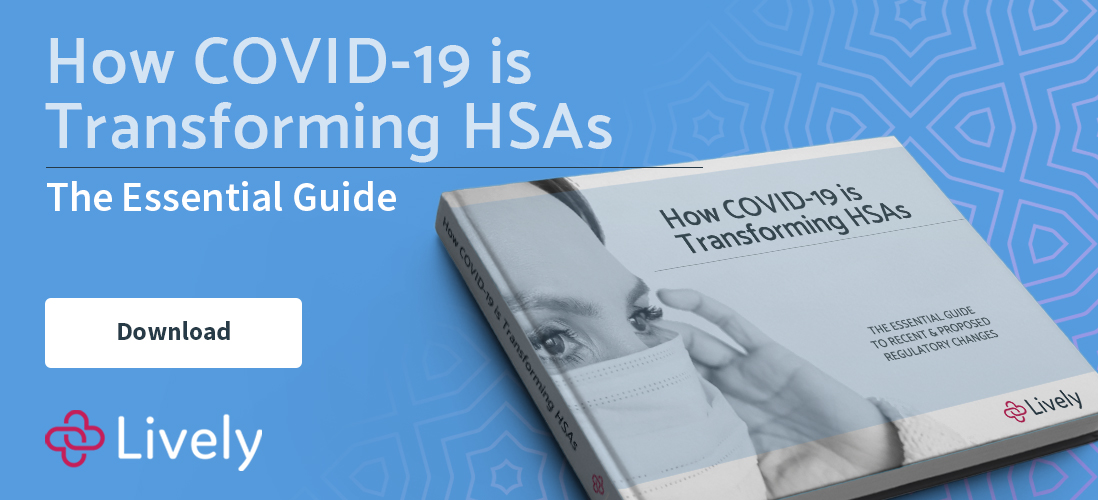The Lively Blog
SIGN UP FOR OUR
Newsletter
Stay up to date on the latest news delivered straight to your inbox
[Webinar Recap] How COVID-19 Has Transformed HSAs and Why They Enhance Today’s Benefit Packages
Renee Sazci · June 11, 2020 · 15 min read

__Jump To:__ - [Regulatory & Legislative Impact](#regulatory-legislative-impact) - [Impact on Healthcare Costs](#impact-on-healthcare-costs) - [How a CDHP Enhances Benefits Packages](#how-a-cdhp-enhances-benefits-packages) The Novel Coronavirus Disease 2019 (COVID-19) has brought rapid regulatory transformation to Health Savings Accounts (HSAs). Within March and April 2020, six regulatory notices modified the way [account holders utilize and interact with their HSA](https://livelyme.com/brokers/). Brokers and employers must stay informed about these changes to ensure that client and employee questions are answered in a timely and comprehensive manner. On May 19, 2020, Lively co-hosted a webinar produced in partnership with BenefitsPro. The speakers included Lively’s Head of Legal, [Jordan Mazur](https://www.linkedin.com/in/jdmazur/); [Kevin McKechnie](https://www.linkedin.com/in/j-kevin-a-mckechnie-b964586/), Executive Director of the Health Savings Account (HSA) Council at the American Bankers Association; and [Michael Olson](https://www.linkedin.com/in/mwolson/), Account Manager at Alliant Insurance Services. The panel of speakers discussed: 1. Modifications to HSA regulations and proposed legislative changes, 2. COVID-19’s impact on healthcare costs, and 3. How Consumer-Driven Health Plans continue to enhance benefits packages. We’ve divided up the webinar by section so you can watch the portions that are of most interest to you—along with a summary of the discussion.
Regulatory & Legislative Impact
### 6 Ways COVID-19 Has Changed HSA Regulation According to [Kevin McKechnie](https://www.aba.com/member-tools/committees-councils/hsa-council), Executive Director of the HSA Council, “from the position of legislative and regulatory change, pandemics add emergency to the time continuum.” This is why in March and April 2020, alone, six regulatory notices were modified. The modifications resulted in the following outcomes. 1. High-Deductible Health Plans can cover [COVID-19 testing](https://livelyme.com/guides/covid19-health-savings-account#how-covid-19-testing-is-covered-by-hdhps-and-hsas?utm\_medium=blog&utm\_source=lively&utm\_campaign=covid19-health-savings-hsa-council-webinar) and treatment pre-deductible. 2. Employer-sponsored group health plans must provide [FDA approved COVID-19 testing](https://livelyme.com/guides/covid19-health-savings-account#families-first-coronavirus-response-act-and-covid-19-testing?utm\_medium=blog&utm\_source=lively&utm\_campaign=covid19-health-savings-hsa-council-webinar) without cost-sharing. 3. The federal income tax filing date was extended to July 15, 2020, with [HSA implications](https://livelyme.com/guides/covid19-health-savings-account#federal-tax-and-hsa-contribution-deadline-extended?utm\_medium=blog&utm\_source=lively&utm\_campaign=covid19-health-savings-hsa-council-webinar). 4. Over-the-counter medical products, including menstrual care, are [permanently HSA-eligible](https://livelyme.com/guides/covid19-health-savings-account#over-the-counter-medical-products-as-qualified-medical-expensesemporarily-covered?utm\_medium=blog&utm\_source=lively&utm\_campaign=covid19-health-savings-hsa-council-webinar). 5. [Telehealth services](https://livelyme.com/guides/covid19-health-savings-account#telemedicine-or-telehealth-services-temporarily-covered?utm\_medium=blog&utm\_source=lively&utm\_campaign=covid19-health-savings-hsa-council-webinar) are temporarily HSA-eligible. 6. The IRS extended the [excess contribution deadline](https://www.irs.gov/pub/irs-drop/n-20-23.pdf) and form 5498-SA filing date. [ ](https://livelyme.com/covid19-hsa-regulatory-guide?utm\_medium=blog&utm\_source=lively&utm\_campaign=covid19-health-savings-hsa-council-webinar) ### 3 Recent Bills Poised to Change Health Savings Accounts The Health Savings Account (HSA) Council is an organization of banks, insurers, and technology leaders committed to increasing the adoption velocity of health savings accounts in the United States. The HSA Council represents its members before Congress, the White House, and U.S. courts to preserve Americans' ability to pay for healthcare using a Health Savings Account. [The HSA Council](https://www.aba.com/member-tools/committees-councils/hsa-council) believes, according to its Executive Director, Kevin McKechnie, that “people with all kinds of private insurance, commercial insurance, or who are enrolled in a government plan like Medicare should also have the ability to open an HSA, at least during a pandemic emergency.” According to McKechnie, the Council’s team is fully deployed and working to have the following three bills enacted. These bills have been selected by the HSA Council—out of many—for their potential to change health savings accounts by decoupling them from the requirement of being covered by only a High Deductible Health Plan (HDHP). Read a summary of each bill below, and register to [receive alerts](https://www.congress.gov/help/alerts). This way, you’ll be able to respond quickly, on behalf of clients and employees, to rapidly evolving HSA regulations. #### 1. Health Savings for Seniors Act (H.R.3796) Currently, if someone is enrolled in Medicare, they are not enrolled in a High-Deductible Health Plan. Therefore, they are ineligible to contribute to an HSA. The Health Savings for Seniors Act “would allow anyone on Medicare, including Medicare Advantage, to keep Medicare and maintain their HSA-eligibility.” __Read more about the [Health Savings for Seniors Act](https://www.congress.gov/bill/116th-congress/house-bill/3796/text?r=4&s=1).__ #### 2. Primary Care Enhancement Act (S.2999) The HSA Council believes that “direct primary care arrangements are extraordinarily important during a pandemic. They offer telehealth services that are now compatible with HSAs under the deductible. The HSA Council thinks it’s the most important thing that Congress could do if it wanted to help people save money. Because, of course, it would make every health insurance program’s out-of-pocket costs also tax-free. Something that isn’t currently the case with any other plan but HSAs.” __Read more about the [Primary Care Enhancement Act](https://www.congress.gov/bill/116th-congress/senate-bill/2999/text).__ #### 3. Pandemic Healthcare Access Act (S.3546) The broadest bill of the three would allow anyone with health insurance to open an HSA. __Read more about the [Pandemic Healthcare Access Act](https://www.congress.gov/bill/116th-congress/senate-bill/3546/text).__ ### 6 HSA Insights & Predictions  In these uncertain times, the HSA Council’s Executive Director, Kevin McKechnie, has identified six HSA insights and predictions. #### Insights: ##### 1. Lasting Changes to HSAs The HSA Council is focused on making the coverage expansions secured in IRS regulation permanent, which are broader than those passed by Congress. ##### 2. Repeal of HDHP Requirement Repealing the requirement of HDHP enrollment to preserve contribution eligibility – pairing HSAs with any health plan, public or private. ##### 3. COBRA Subsidy Debate Will Congress choose to support the employer system with subsidies for furloughed workers’ private insurance, or will Congress accelerate the adoption of Medicaid expansion and/or Affordable Care Act (ACA) subsidies in the wake of the SCOTUS decision that Congress underfunded ACA exchanges? #### Predictions ##### 4. A Greater Number of HSA Converts Relative to other plans, the value proposition of HSAs is increasing. __Prediction: Businesses will convert to HSAs at an increasing rate in 2021-2022.__ ##### 5. HDHP and HSA Spike [Medical costs](https://livelyme.com/how-fast-health-insurance-premiums-increasing?utm\_medium=blog&utm\_source=lively&utm\_campaign=covid19-health-savings-hsa-council-webinar) will increase significantly in 2021 and beyond due to COVID-19 dynamics. __Prediction: Look for enrollment spikes in Medicaid and ACA plans (likely individual HDHP coverage + HSA adoption).__ ##### 6. Telehealth and Telemedicine Expansion Increasing virtualization and home-centric care. __Prediction: [Telehealth](https://livelyme.com/telemedicine-brokers-anticipated-demand?utm\_medium=blog&utm\_source=lively&utm\_campaign=covid19-health-savings-hsa-council-webinar) services and home delivery models grow and should expand Direct Primary Care (DPC) arrangements.__
Impact on Healthcare Costs
### Projected Healthcare Costs Before COVID-19 On March 23, 2020, before COVID-19 brought unprecedented changes to Americans and the healthcare sector, The Centers for Medicare and Medicaid Services (CMS) released their National Health Expenditure Projections report for 2019-2028. CMS projected that private [health insurance premiums](https://livelyme.com/how-fast-health-insurance-premiums-increasing?utm\_medium=blog&utm\_source=lively&utm\_campaign=covid19-health-savings-hsa-council-webinar) might grow an average of 4.65% per year between 2019 and 2018 - an estimated 41.9% over nine years. They also estimated that total healthcare spending per person would grow from $11,000 to $17,000 by 2027. But now, COVID-19 has brought new health care considerations, causing some to estimate an increase in healthcare costs, while others project a decline. ### Uncertainty and Variation in Healthcare Cost Predictions COVID-19 has heightened healthcare cost uncertainty for employers and employees. Health carriers are setting rates for 2021, and there has been much speculation about how health insurance premiums will change from COVID-19 alone. Some COVID-19 and healthcare considerations include: 1. Costs of COVID-19 testing and treatment. 2. Forgone elective procedures, outpatient care, or pharmacy use. 3. Delayed care due to reduced access or concerns about contracting the virus. 4. Will States be able to provide individual subsidies at the same level due to COVID-19? 5. Where do we go from here? How long are we in this situation, and what do the next three, six, or 12 months look like? 6. How much relief will be passed to aid the healthcare sector?  In March 2020, the consensus seemed to be that healthcare costs could rise. In a report released on March 28, 2020, the [Wakely Consulting Group](https://www.ahip.org/new-study-covid-19-health-care-costs-could-reach-556-billion-over-two-years/) estimated that costs to the healthcare system from COVID-19 could range from $56 billion to $556 billion over the next two years. Willis Towers Watson’s [Best Practices in Health Care Employer Survey](https://www.willistowerswatson.com/en-US/News/2020/03/us-employers-face-significant-health-care-benefit-cost-increases-from-covid19) estimated that because of COVID-19 testing and treatment, health insurance premiums could jump as much as 7% on top of the 5% increase (12% in total) employers previously projected for 2021 (March 26, 2020). And [Covered California](https://hbex.coveredca.com/data-research/library/COVID-19-NationalCost-Impacts03-21-20.pdf) released a report that projected 2021 premium increases to individuals and employers, from COVID-19 alone, could range from 4% (9% in total) to more than 40% (45% in whole), on top of the 5% projected increases (March 22, 2020). But as March ended, a new conversation surfaced surrounding a healthcare cost decline due to individuals forgoing elective procedures and outpatient care, and delayed care due to reduced access or concerns of contracting COVID-19. According to [Milliman](https://www.milliman.com/en/insight/Estimating-the-impact-of-COVID19-on-healthcare-costs-in-2020), April estimates suggested a net reduction in medical costs for healthcare payers by at least $75 billion and as much as $575 billion if the deferral and elimination of care continue through the end of 2020 (April 23, 2020). They projected the effects “of service deferral and elimination would greatly exceed the cost of testing and treating COVID-19 in 2020. This revenue reduction for providers could have a broad range of implications, from furloughed healthcare employees to physician practice and medical facility closures.” A survey of health insurers conducted by [eHealth Inc.](https://www.benefitspro.com/2020/04/14/covid-19-may-have-this-shocking-effect-on-2021-health-insurance-premiums-412-96426/) (April 2, 2020) found that 83% of insurer respondents said that they do not anticipate raising rates in 2021 as a result of the crisis, while 17% expected to raise rates no more than 5%, which is on par with “business-as-usual” premium cost increases. But it’s Peterson-KFF’s April 15, 2020 study on [health costs](https://www.healthsystemtracker.org/brief/how-health-costs-might-change-with-covid-19/) that sums up the general sentiment; “there is extreme variation in estimates due to remaining uncertainty about the extent of the outbreak.”
How a CDHP Enhances Benefits Packages
### What is a Consumer-Driven Health Plan? A [Consumer-Driven Health Plan](https://livelyme.com/3-reasons-employer-consumer-driven-health-plan-increasing?utm\_medium=blog&utm\_source=lively&utm\_campaign=covid19-health-savings-hsa-council-webinar) (CDHP) is the marriage of a qualifying High-Deductible Health Plan (HDHP) with a pre-tax payment account like a Health Savings Account, Flexible Spending Account, or Health Reimbursement Account. The specific employer and employee situation will determine the best tax-favored account pairing. In many cases, an [HSA](https://livelyme.com/hsa-guide?utm\_medium=blog&utm\_source=lively&utm\_campaign=covid19-health-savings-hsa-council-webinar) is the most favorable when aligned with an HDHP. ### Qualifying High-Deductible Health Plan in 2020 For a health plan to qualify as a High-Deductible Health Plan, a minimum deductible and a maximum out-of-pocket expense must be met, as established by the IRS. These amounts change annually according to inflation. For an HDHP to qualify as [HSA-eligible in 2020](https://livelyme.com/hsa-eligibility-details?utm\_medium=blog&utm\_source=lively&utm\_campaign=covid19-health-savings-hsa-council-webinar) it must have: __For an individual__: - Deductible of at least $1,400 - Yearly out-of-pocket expenses (including deductibles, copayments, and coinsurance) no more than $6,900 - The deductible must be paid in full before the insurance company starts to pay its share. __For a family:__ - Deductible of at least $2,800 - Yearly out-of-pocket expenses (including deductibles, copayments, and coinsurance) no more than $13,800 - The deductible must be paid in full before the insurance company starts to pay its share. Employees can receive their preventative care, such as annual check-ups, well-woman, well-baby/child, and immunizations (including the COVID-19 vaccine, once available) free of charge. With an HDHP, the deductible must be paid in full by the employee before the insurance begins to pay its share. While there are benefit restrictions on HDHPs, there is still flexibility to design an offering strategically. The underlying plan is key to how the tax-favored account will function. ### HSAs are the Smartest Way to Plan for Today and Tomorrow  An HSA enables employees to set aside pre-tax funds from their paychecks to spend on qualifying health-related expenses, plus save for the future and potentially earn on investments. HSAs are like a 401(k) for your health, but better. Like a 401(k), an HSA has the possibility of earning interest and investment returns, and any balance not used throughout the year for medical expenses rolls over year-to-year. HSA funds can be withdrawn for eligible medical expenses and services at any time, without paying taxes on them. #### Here are the benefits for employees and employers: __Employees:__ - Tax-deductible contributions - Tax-free investment gains and interest - Tax-free withdrawals for qualified expenses __Employers:__ - Expand employee benefits offerings - Reduce cost and contribute pre-tax - Attract and retain top talent One interesting point during COVID-19 is the reduced employer cost. With carriers paying fewer claims during the first few months of the virus, fully-insured employers offering a CDHP have effectively lowered their fixed cost and realized some of the short-term downturns in cash flow. ## 5 Unique Attributes of HSAs There are three methods of creating a Consumer-Driven Health Plan: HDHP plus an HSA, FSA, or an HRA. Unlike HRAs and FSAs, Health Savings Accounts have the following unique attributes that make them more flexible to use for short-term medical needs or retirement healthcare savings. 1. The HSA account is fully portable between employers; the individual owns the account. 2. All unused amounts carry over year-to-year and can be spent even if the employee isn’t currently enrolled in a CDHP. 3. Interest may accrue, and funds can be invested depending upon the custodian and the type of deposit account. 4. Claims do not need adjudication. 5. Funds can be used for ineligible expenses, but are subject to a 20% penalty unless after account beneficiary's disability or death. ### What Employers Are Considering for 2021 Enrollment  Every employer is impacted by the COVID-19 pandemic differently, and tailoring the response to employee benefits based upon the extent to which their business is affected will be critical. #### Minimally Impacted Employers - Employers may consider promoting existing services offered through the core health plan, employee assistance programs (EAPs), or well-being programs. - They may support employees emotionally, physically, and financially with as little disruption possible. - The value of [telemedicine](https://livelyme.com/telemedicine-employer-health-care-delivery?utm\_medium=blog&utm\_source=lively&utm\_campaign=covid19-health-savings-hsa-council-webinar) will continue to be communicated, and the service promoted as employers try to ride the increase of virtual visits, even after the pandemic. - Most major carriers include virtual visits as a plan benefit, but for those that don’t, it should be a consideration. #### Moderately Impacted Employers - Employers should prioritize driving enrollment to CDHPs, narrow provider networks, and increasing plan restrictions. - Employers will be more likely to approve changing carriers or benefit designs that provide cost savings. The HSA contribution share may be reviewed for reductions. #### Severely Impacted Employers - Employers will consider removing non-essential programs and could provide employees a CDHP as a total replacement option. ### How CDHPs Could Be A Solution for You  When [implementing a CDHP](https://livelyme.com/how-to-introduce-consumer-driven-health-plan-employees?utm\_medium=blog&utm\_source=lively&utm\_campaign=covid19-health-savings-hsa-council-webinar) for the first time, there are financial, cross-functional, compliance, and communication considerations to take into account. Both the employee and employer contribution process should be discussed with the HSA custodian and the employer’s payroll team before launch. Keep in mind that the more comfortable you make it for employees, the more success the business will have launching a CDHP offering. #### Administrative Considerations - How will employees contribute to the account? Through payroll deductions? Or will they work with the account custodian and claim deductions during tax season? - Can the benefits system support the changes you are trying to make? - Is the payroll team aware of the changes you are making? Do they know how to deduct funds if you allow employees to contribute through payroll? Are they aware employees may have additional questions during tax season? - The administration is critical, and the recipe for a successful launch is talking through all situations with key stakeholders. #### Enrollment and Communications Considerations - A robust financial incentive, through employer account funding or lower premium contributions, is essential to bolstering enrollment. CDHPs take some getting used to. With proper communication, employees will see the benefit. - All too often, employers present the CDHP plan as a sales pitch, prompting the response, “what’s the catch?” - To avoid pressuring employees, a better method is to present the plan educationally through as many avenues as possible. - The cons of the plan should be discussed as well, such as additional administration for the employee (with the tax-advantage comes responsibility). Cash flow can also be problematic during a plan year since the deductible is in effect day one, but savings from reduced premiums are prorated. - A dedicated resource for employee questions is critical to help employees feel supported in their transition. ## Summary 1. As a result of COVID-19, HSA legislation is expanding to support individuals and families facing rising healthcare costs. This could lead to temporary regulations being made permanent and businesses offering HSAs at an increasing rate. 2. COVID-19 has brought about the rapid development of telemedicine to bridge the gap between physicians and patients, especially COVID-19 symptomatic patients. The benefit will be more frequently used now that the service is HSA-eligible and more people realize its cost, access, and time-saving benefits. 3. Many hypothesize that COVID-19 will bring rising healthcare costs. Still, there is extreme variation in estimates due to remaining uncertainty about the extent of the outbreak and resulting reduction and deferral of care. 4. With the decline and deferral of care, some also hypothesize healthcare employees’ furloughs, physician practice, and medical facility closures. But underlining all of this is uncertainty. It’s too early to say which way things will end up. 5. Employers are making 2021 benefits decisions based on whether their business is minimally, moderately, or severely impacted by the COVID-19 pandemic. 6. As healthcare costs rise, more companies will turn to Consumer-Driven Health Plans (High-Deductible Health Plan + Health Savings Account) to minimize costs and offer employees pre-tax healthcare savings. [](https://livelyme.com/covid19-hsa-regulatory-guide?utm\_medium=blog&utm\_source=lively&utm\_campaign=covid19-health-savings-hsa-council-webinar)

Benefits
2025 and 2026 Maximum HSA Contribution Limits
Lively · June 20, 2025 · 3 min read
On May 1, 2025, the IRS announced the HSA contribution limits for 2026: $4,400 for individual coverage and $8,750 for family coverage. That’s a $100–$200 increase from the 2025 limits, which are $4,300 and $8,550 respectively. If you’re 55 or older, you can still contribute an extra $1,000.

Benefits
What is the Difference Between a Flexible Spending Account and a Health Savings Account?
Lauren Hargrave · February 9, 2024 · 12 min read
A Health Savings Account (HSA) and Healthcare Flexible Spending Account (FSA) provide up to 30% savings on out-of-pocket healthcare expenses. That’s good news. Except you can’t contribute to an HSA and Healthcare FSA at the same time. So what if your employer offers both benefits? How do you choose which account type is best for you? Let’s explore the advantages of each to help you decide which wins in HSA vs FSA.

Health Savings Accounts
Ways Health Savings Account Matching Benefits Employers
Lauren Hargrave · October 13, 2023 · 7 min read
Employers need employees to adopt and engage with their benefits and one way to encourage employees to adopt and contribute to (i.e. engage with) an HSA, is for employers to match employees’ contributions.
SIGN UP FOR OUR
Newsletter
Stay up to date on the latest news delivered straight to your inbox
